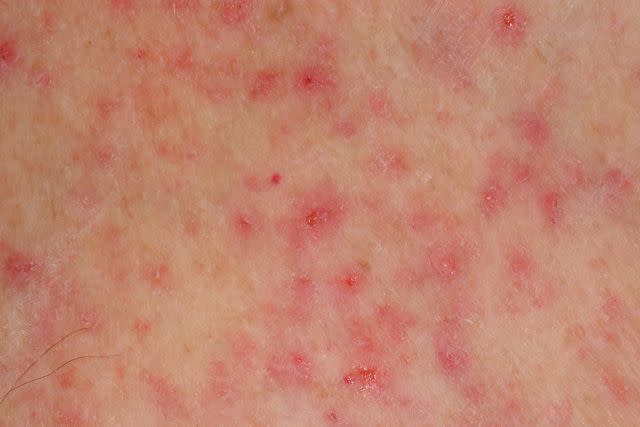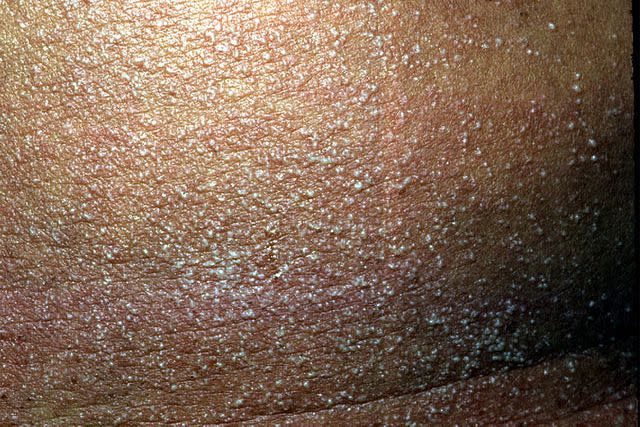Heat Rash: How It Looks and What to Do
Medically reviewed by Casey Gallagher, MD
Heat rash, also known as eccrine miliaria, sweat rash, and prickly heat, is a skin rash that causes the skin to turn red and feel warm or prickly (stinging). It also causes small red dots in the affected skin area in people with lighter skin tones and darker spots in people with darker skin tones.
Heat rash occurs in adults and children when the body sweats more than usual. It is more common during the summer months or in hot, dry climates.
Heat rash can also affect newborns because their eccrine sweat glands are not yet fully developed. Eccrine sweat glands open directly onto the surface of the skin and are found in most areas of the body. In newborns, the rash may appear as thin blisters or tiny water blisters on the face, trunk, and arms.
This article will cover what heat rash looks like, finding immediate relief, prevention, and more.

COROIMAGE / Getty Images
How Does Heat Rash Look?
Heat rash can be identified by skin location and appearance. It can develop anywhere the body sweats, but the neck, scalp, chest, groin, and underarms are the most commonly affected areas in adults and older children.
The most common symptoms are itching and small bumps in the affected skin area. In people with lighter skin tones, these bumps may appear red. In people with darker skin tones, they may appear darker than the surrounding skin.
Symptoms in infants often appear on the neck, chest, and upper back. Older children may experience a prickly pins-and-needles feeling, and babies may have tiny water blisters in the affected skin area.

Reproduced with permission from © DermNet dermnetnz.org 2024.

Reproduced with permission from © DermNet dermnetnz.org 2024.
Location
Heat rash can present in different ways and on different skin areas. It is caused by blockage and inflammation of the eccrine sweat ducts.
Heat rash is sometimes divided into three categories based on the level of blockage of the sweat ducts. Categories are:
Miliaria crystallina: This subtype occurs due to sweat duct obstruction close to the skin's surface. It presents as blisters on the neck, head, and upper trunk.
Miliaria rubra: This subtype obstructs the mid-epidermis—the deeper layers of the skin. In adults, this type of heat rash affects the upper trunk, scalp, neck, and body fold areas that rub against clothing. In children, it affects the trunk and skin of the neck, groin, and armpits. It sometimes causes pustules (raised, pus-filled growths) on the trunk and extremities.
Miliaria profunda (tropical anhidrosis): This heat rash subtype affects the sweat glands in the middle layer of skin (at or below the dermo-epidermal junction).
Onset of Symptoms
Symptoms of heat rash typically come quickly. The rash will appear within minutes to hours of excessive sweating.
Sweating is the body's response to heat and is intended to cool. When sweat leaves the pores of the skin, it evaporates and takes body heat with it.
If the skin's ducts become clogged, sweat cannot reach the surface and evaporate. It will become trapped and can cause heat rash.
Related: What Causes Sweating?
Appearance and Texture
Depending on the type of heat rash you are experiencing, the appearance and texture of the rash will differ.
Miliaria crystallina presents as a clear or skin-colored heat rash. The rash will present with fluid-filled bumps on the skin. It can affect up to 9% of newborns.
Miliaria rubra is the type of miliaria often called prickly heat because it causes a burning itch and presents as red-colored in lighter skin tones and gray, purple, or dark brown in darker skin tones. This type of heat rash is more common in adults than children. If this type of heat rash causes pustules, the affected skin area may appear white or yellow. Pustules can be painful or become infected.
Miliaria profunda causes a heat rash that occurs deep into the skin layers and occurs frequently (chronic). It can cause skin inflammation (swelling and redness), irritation, and infection. Miliaria profunda sometimes presents with large, firm skin bumps when exposed to heat. It can also cause systemic symptoms like nausea and dizziness.
Skin Tone Presentation
Heat rash can present differently on different skin tones. For example, heat rash on lighter skin tones often is red, and on darker skin tones, it can be a gray, purplish, or dark brown.
The difference is due to the amount of melanin in the skin. Melanin is the substance that gives hair, skin, and eyes their color (pigment).
Related: What a Heat Rash Looks Like on Darker Skin (and What to Do Next)
Sensations
Heat rash can be uncomfortable, and some types are more painful than others. For example, the small, inflamed blisters of miliaria rubra can be extremely itchy. On the other hand, milaria crystallina's clear, fluid-filled bumps tend to not be painful or itchy.
Extreme itch is a symptom of the most painful type of heat rash, miliaria profunda. If it causes pustules, the pus-filled bumps may become inflamed and swollen.
Heat Exhaustion
Heat rash can sometimes be present along with heat exhaustion. With heat exhaustion, the body overheats and cannot cool down.
Symptoms of heat rash include:
Dizziness
Nausea
Confusion
Is It a Heat Rash or a Skin Allergy?
The main difference between a heat rash and a skin allergy is that heat rashes occur in warm weather, especially when you're outdoors and sweating and your sweat ducts become obstructed.
An allergy is an immune response to an allergen, such as plant, cosmetic, metal, food, or insect bites. A skin allergy may present with hives—red, raised, itchy bumps that may burn and sting. Hives typically present in more than one body area, whereas a heat rash appears in one affected area.
Additional skin conditions that may look like heat rash are:
Acute generalized exanthematous pustulosis (AGEP): A rare skin reaction related to medication
Bacterial folliculitis: Inflammation or infection of one or more hair follicles
Fungal skin infections: A skin rash caused by fungi
Grover's disease: A skin disorder that causes an itchy rash on the back and chest. It is twice as common in people assigned male at birth and most often occurs in White adults after age 60.
Herpes simplex: A virus that causes skin infections
Toxic erythema of newborn: A benign (harmless) skin condition that affects newborns
Immediate Relief to Soothe Heat Rash
Some home remedies can provide quick relief for heat rash. Home remedies that can help include:
Cool bath or shower: A cool bath or shower can help cool the body and unclog pores in the affected skin area. After bathing, air dry the skin rather than rub it down with a towel.
Get out of the heat: Avoiding heat and moving to an air-conditioned area can help reduce sweating and prevent the rash from worsening. If you don't have access to air conditioning, use fans to keep your home cool. If you cannot keep your home cool, consider going somewhere cooler, such as a mall or a friend's home.
Apply cold compresses: Cool compresses can cool and soothe affected skin. To protect the skin, wrap ice or gel ice packs in a towel.
Take an oatmeal bath: An oatmeal bath can help reduce the itch caused by the heat rash. Add 1 to 2 cups of oatmeal to a lukewarm bath. Oats have anti-inflammatory properties that can treat itch and irritation. You might also consider making a paste of one part oatmeal to one part water and applying it to the affected heat rash area.
Aloe vera: Pure aloe vera gel can soothe heat rash. Its anti-inflammatory properties can cool down affected skin. Use aloe sparingly to avoid further clogging the skin pores.
Wear light, loose-fitting clothing: Wearing light, loose-fitting clothing helps you to avoid irritation of your skin. If the heat rash affects the groin or under the breasts, it might help to avoid wearing undergarments until the rash clears up.
For an infant with heat rash:
Remove or loosen the child's clothing.
Move the child to a cool, shady area.
Cool the child with cool compresses or a cool bath.
Allow the baby's skin to air dry rather than using a towel.
To avoid irritation, do not use ointments and lotions on your baby's skin. If your child's rash gets worse or if they develop a fever, seek immediate medical attention.
Managing Heat Rash Over Several Days
Heat rash typically resolves in a few hours, but if it is severe, it may take days or weeks to go away. A severe rash may require over-the-counter (OTC) treatments.
It is always a good idea to check with your healthcare provider before using OTC medicines to manage heat rash.
OTC options for managing heat rash include:
Antihistamine medicines: Benadryl or other antihistamine medications may relieve heat rash symptoms, especially inflammation and itching.
Steroid creams: Steroid creams like hydrocortisone can help treat heat rash by reducing inflammation, itch, and irritation. Apply a thin layer of cream over the affected area and rub until the cream is fully absorbed to avoid further blocking sweat glands.
Calamine lotion: Calamine lotion can treat discomfort and itch related to heat rash. You can find calamine lotion over the counter at a drugstore or pharmacy.
Related: Heat Rash: What It Looks Like and How to Treat It
When to Consult a Healthcare Provider
If you experience severe symptoms of heat rash, contact a healthcare provider. Severe symptoms include:
Pain
Severe itching
Rash that feels warm
Signs of infection (fever, nausea, severe skin swelling in the affected area, or blisters that leak fluid or pus)
Heat rash that does not improve with home treatment or lasts longer than a few days
For an infant or younger child, contact your child's healthcare provider if:
The heat rash area looks infected, even without a fever.
The rash has not gone after three days of home treatment.
If you feel the child needs to be seen or if you have other concerns for the child's health.
Staying Ahead of Heat Rash on Hot Days
While heat rash typically isn't dangerous, it can be uncomfortable. Fortunately, it is preventable.
You can prevent heat rash by:
Staying cool: During the hot, humid summer months, try spending more time in cool environments. An air-conditioned area is ideal, but even a fan or shade can help. You can also cool down with a cool shower or bath or by taking a dip in a pool.
Wearing light, loose clothing: Wearing lighter, looser clothing can help reduce sweating and keep skin dry.
Keeping skin dry: Avoid intense exercise that causes excessive sweating when outdoors in hot, humid weather. Change out of wet and sweaty clothing after working out or returning from the outdoors.
Good skin care: Keep skin clean with gentle daily exfoliation when showering or bathing to unclog skin pores.
Avoid ointments, creams, and harsh soaps: Some creams and ointments can clog sweat glands. Opt for gentle, fragrance-free soaps when bathing.
Stay hydrated: Make sure you and your child are drinking plenty of water when outdoors on hot days.
Summary
Heat rash is a common but uncomfortable skin irritation that occurs during hot and humid weather. Different categories of heat rash cause varying symptoms, including clear, fluid-filled blisters and red or dark itchy bumps. Heat rash can affect anyone, including infants and children.
Cooling down and wearing loose, lightweight clothing can help manage heat rash. If symptoms of heat rash last longer than a few days, if the rash is severe or painful, or if you or a child shows signs of infection, including fever, contact a healthcare provider.
Heat rash is a preventable condition. During the summer months, you can reduce your risk by staying cool and hydrated, avoiding exercise in hot, humid weather, and keeping your skin clean and free of creams and ointments.
Read the original article on Verywell Health.

